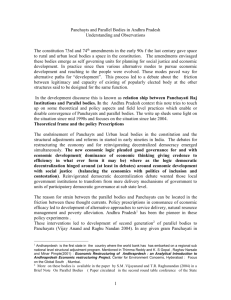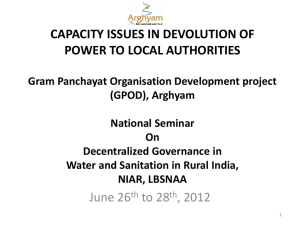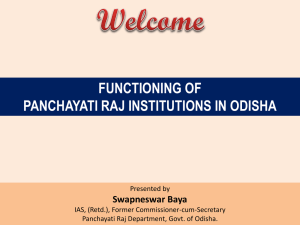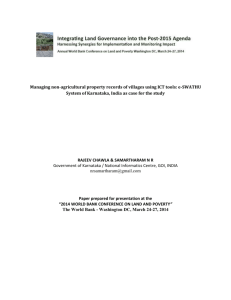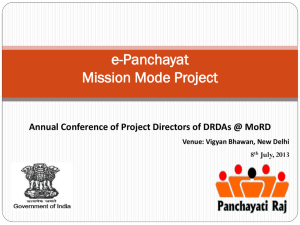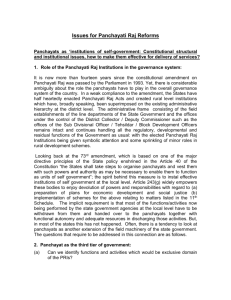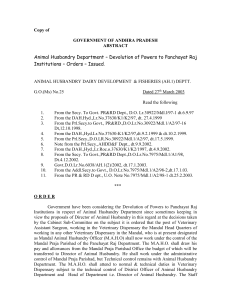History of Panchayati Raj in Karnataka
advertisement
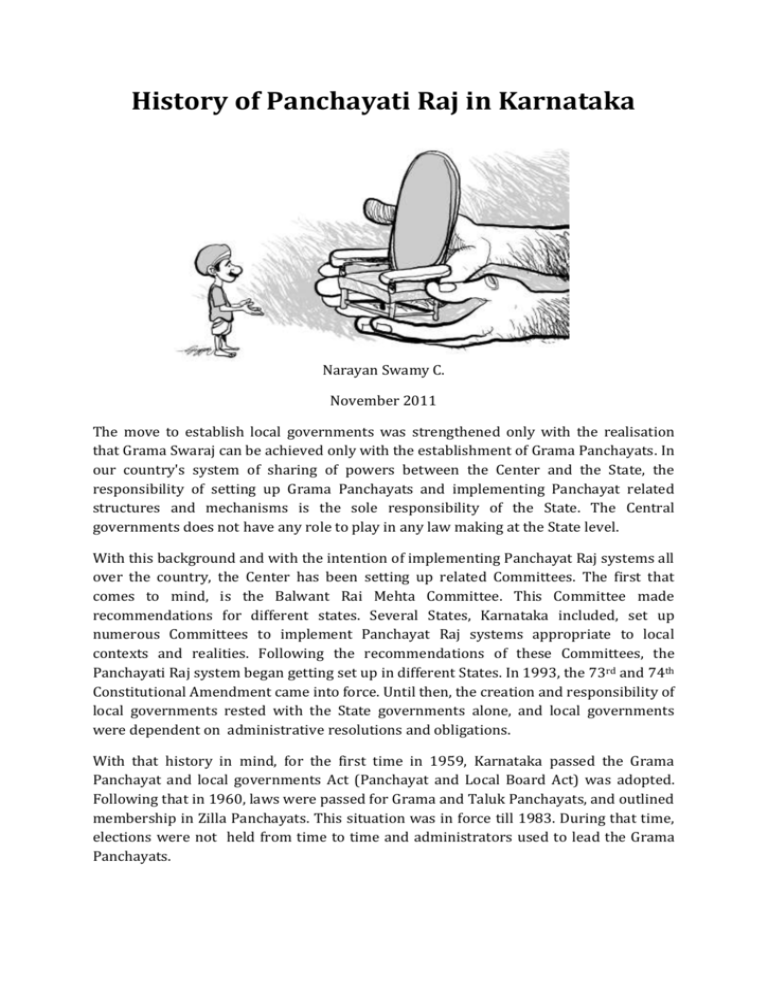
History of Panchayati Raj in Karnataka Narayan Swamy C. November 2011 The move to establish local governments was strengthened only with the realisation that Grama Swaraj can be achieved only with the establishment of Grama Panchayats. In our country's system of sharing of powers between the Center and the State, the responsibility of setting up Grama Panchayats and implementing Panchayat related structures and mechanisms is the sole responsibility of the State. The Central governments does not have any role to play in any law making at the State level. With this background and with the intention of implementing Panchayat Raj systems all over the country, the Center has been setting up related Committees. The first that comes to mind, is the Balwant Rai Mehta Committee. This Committee made recommendations for different states. Several States, Karnataka included, set up numerous Committees to implement Panchayat Raj systems appropriate to local contexts and realities. Following the recommendations of these Committees, the Panchayati Raj system began getting set up in different States. In 1993, the 73 rd and 74th Constitutional Amendment came into force. Until then, the creation and responsibility of local governments rested with the State governments alone, and local governments were dependent on administrative resolutions and obligations. With that history in mind, for the first time in 1959, Karnataka passed the Grama Panchayat and local governments Act (Panchayat and Local Board Act) was adopted. Following that in 1960, laws were passed for Grama and Taluk Panchayats, and outlined membership in Zilla Panchayats. This situation was in force till 1983. During that time, elections were not held from time to time and administrators used to lead the Grama Panchayats. At the national level, there are many examples of States – Gujarat, Maharashtra, or even West Bengal. In 1988 in West Bengal, the ruling party amended the existing Panchayat Raj Act and ushered in a new system with 3 tiers of government. An interesting point to note is that even without the Constitutional Amendment, West Bengal has been conducting elections to Panchayats every five years since 1978 without any interruption of even a single day. In Karnataka Panchayati Raj system was the dream child of D. Abdul Nazir Sab. The respected Ramakrishna Hegde believed in this vision, and gave strength to it, facilitating its adoption in 1983. However, to become official, it required the approval and adoption by the Center and by the Prime Minister, therefore it was pronounced as law only in 1985. In 1987 for the first time elections were held for Zilla and Mandal Panchayats. The 1985 law detailed the role and functions of the Zilla Panchayats, the Taluk Panchayats and legal committees. However, the implementation of this law was brought to a conclusion soon after it was set in place, due to the discussions of several Committees set up related to the Constitutional Amendment, particularly the Ashok Mehta Committee. These committees made recommendations for the ushering in of Panchayat Raj institutions based on a Constitutional Amendment, and proposed that only through this way will the Panchayat system be impact-ful. This Amendment gained the majority vote in the Lok Sabha, but it fell one vote short in the Rajya Sabha. Therefore, then PM, Hon. V.P Singh introduced a draft bill, but before it could be brought up for discussion, he had to relinquish power. Later, in 1991 the ruling party at the Centre under the Prime Minister-ship of Hon. P.V Narasimha Rao, introduced another draft bill pertaining to rural areas. In that Hon. Ram Nivas Mirza, the senior ex-Minister presented a detailed examination of the aspects relating to Grama Panchayats in this bill to the entire House. He organised a large convention with all political parties and submitted a documentation. It was on the basis of this submission that the 73rd and 74th Constitutional Amendment bills came into force. The 73rd exclusively dealt with the Gram Panchayat system. It mandated that whichever states have a population greater than 20 lakhs, they should introduce a three-tier system of Panchayat Raj. As a result of this mandate, the 2-tier system of Panchayati Raj existing in Karnataka could not be taken forward. The 74th Constitutional Amendment dealt exclusively with city local governments. The aspect that is common to both is captured in teh 74th Amendment, and it was because of this that the concept of District Planning Committee (DPC) was included in the Constitution of India. The District Planning Committees are something that we greatly neglect. The 74th CAA spoke strongly of the necessity to realise the DPC. It mandated that within 1 year of the CAA coming into force, every single district in the country should implement this. If a Constitutional Amendment that is related to a State subject, then it needs to be passed by 2/3 rd majority in both Houses of Parliament. Additionally, it needs to be passed by more than half vote in the State Legislative Assemblies. All the State Assemblies passed these Amendments unanimously and gave assent to it. This is important because it indicates that all political parties in all States are obligated to these Amendments. Following the Constitutional Amendments, the first state in the whole country to implement the threetier Panchayati Raj system was Karnataka. The Karnataka Panchayati Raj Act is still in force today, despite several amendments, and elections to the Grama Panchayats under this Act occurred in December 1993. There are several interpretations about the Constitutional Amendments. Just as conducting the elections to the State Assemblies and the Legislative Houses are the responsibility of the State Election Commissions (SEC), similarly the responsibility of elections to the Grama Panchayats also rests with the SEC. However, this is a Constitutional mechanism that should be similar at the Centre and in all States. One is not subordinate to the other. Another structure is the Finance Commission. There exists a Central Finance Commission which looks into how sharing of money and resources happens between the Centre and the States. Earlier, the Central Finance Commission recommendations did not cover issues of local governments, and this began getting covered only after the CAA. Importantly, whatever recommendations the CFC makes, both the Centre and the States are mandated to comply. However, although the State Finance Commissions are a part of the Constitution, their recommendations are not mandates for the States. In several cases, the States do not accept the recommendations made by State Finance Commissions. At the State level, the government says that the recommendations have been accepted. However, either in the annual plans or the FiveYear plans, we have not seen these recommendations being implemented. Karnataka is also in the same institution. The District Planning Committee is very important. When we hear the word decentralisation, we mostly speak about administrative decentralisation. However, for true development to occur, what is required is decentralisation of planning. The government makes many announcements at several levels regarding the programmes that should happen every year. Following this, local institutions should discuss it in the Grama Sabha, Grama Panchayat, Zilla Panchayat, etc, and make their recommendations and plans to table before the District Planning Committee. The Zilla Panchayat President is the President of the District Planning Committee. The recommendations from local institutions should be discussed in the District Planning Committee and once sent to the State Government, the State does not have the legal authority to make any changes to the plan. If there are any State or Central preferences for programmes, they should be brought to the attention of the District Planning Committee as suggestions and recommendations, and the Committee needs to avail of grants for these and bring them into implementation. However, until today, several States – including Karnataka – have not created the District Planning Committees as per the description provided above. Other than saying that the District Planning Committees have been set up, there has not been any initiation of work. Till today, the State has not been able to give us a clear picture of whether and how it is functioning. It is not clear if the District plans that are being released are made by the District Planning Committee or not. The Committee have not yet gained a true meaning under decentralisation. The fact that the Committees are not functioning in Karnataka is very unfortunate. Secondly, according to our State laws, a State Panchayat Council is to be established. The Hon Chief Minister will be the President of this and the Minister for Rural Development and Panchayati Raj will be the Vice-President. Additionally, Panchayat representatives from different levels will be members of the Council. Earlier, we had the process of District Councils, where the Chief Minister used to coordinate the meetings. The reason was to have a space for the Chief Minister to understand our feelings and problems and discuss and find solutions. However the government is not giving any attention to this now. There is most definitely no place where the Constitution refers to State-level Minister representatives playing instrumental roles in the Panchayati Raj institutions. On the other hand, there are clear reservations for SC, ST and women in Panchayat Raj institutions, while there are no reservations for any other forms of marginalised groups. Decisions on these additional reservations have been left to the State Assemblies. The Constitutional Amendment related to Panchayati Raj was made in 1993. Since that time, there have been many changes in the situation in our country and in the States. Now, there is a need to have an amendment to the Constitutional Amendment itself. There is a need for Karnataka to make a recommendation in this regard as well.
